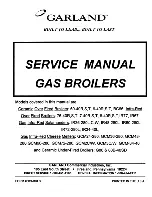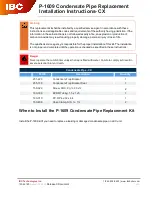
4.2 Installing a System Application
Refer to the following examples to properly implement a
system for space heating, DHW supply, or both. These examples
are provided to suggest basic guidelines when you installing
the boiler system. However, the actual installation may vary
depending on the circumstances, local building codes or
regulations.
CAUTION
technicians, authorised to do so.
For correct installation, all the requirements and
recommendations described in the Regulation for
Heating Installations in Buildings (RITE) must be
complied with, together with all other national and/or
local regulations applicable at the time of installation.
M
M
M
S Plan Layout
Y Plan Layout
Note
Refer to the “7. Setting the DIP Switches” and “11.5
Setting the Parameters” to control the boiler using the
external CH Controller and DHW Tank.
When installing the system, follow these guidelines:
as solder), that are approved for use in potable water systems.
Tighten the connection valves with care to avoid damage.
The external hydraulic bypass valve is required.
An additional expansion vessel must be installed to the
system in the central heating return.
4.3 Connecting the Condensate Drain
Line
The Navien NCB LHWE boiler creates condensation when it
operates. This condensation has an acidic pH of 3-5. Follow
all local codes and regulations when disposing of condensate
from the boiler. We recommend draining the condensate into
a laundry tub, as the alkali in laundry detergent will neutralise
the acid in the condensate. However, other suitable waste drain
locations may be used according to the local legislation.
CAUTION
Do not cap or plug the integrated condensate line. If
prevented from draining, condensate can damage the
boiler.
The condensate line must have a negative slope to drain
properly.
The requirements recommended for the condensate drain line
installation are as follows:
For correct condensate drain line installation, the tube must
have a minimum diameter of Ø21.5 mm.
The tube must be made of a material that can withstand
corrosion, e.g. PVC, PVC-U, ABS, PVC-C or PP. It must not be
made of metal.
For safety reasons, the end of the tube must be as close as
possible to the draining point.
When the condensate drainage is connected to a general
that could occur inside it must be taken into account,
installing suitable pressure release and ventilation elements.
The length of the tubes outside the building must be as short
as possible. They must also be installed with as much tilt as
possible. The tubes must be insulated if they are exposed
to extremly cold weather or blizzards. If the tubes are not
insulated, they must have a diameter of at least Ø32 mm.
The drain tube must have a minimum tilt of 2.5° downstream
of the boiler.
For tubes with Ø21.5 mm, the maximum permitted length is
3 metres.
If the appliance is installed in a non-heated premises, the tube
system must be treated as if it was an outdoor installation.
To prevent the risk of tripping, the outdoor tubes must be
22 Installing the System Piping
Summary of Contents for NCB-20LHWE
Page 41: ...41 Wiring Examples for Different Applications...
Page 71: ...71 13 4 Ladder Diagram 3 15A Appendices...
Page 75: ...Memo...
Page 76: ...Memo...
Page 77: ...Memo...
Page 78: ...Memo...
Page 79: ......
















































